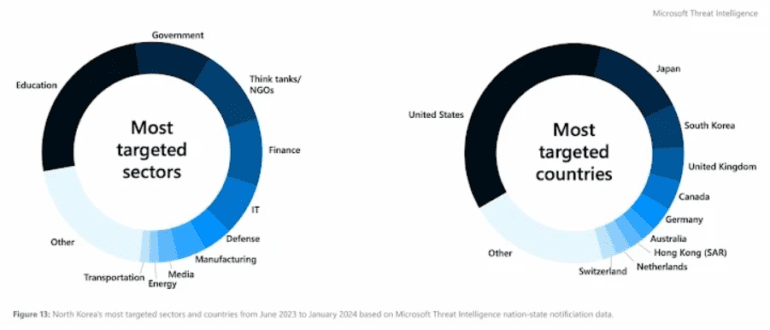- North Korean state-sponsored cyber groups are leveraging artificial intelligence (AI) to enhance their cyber espionage operations.
- Microsoft warns of the use of AI-powered large language models (LLMs) by groups like Emerald Sleet for spear-phishing and reconnaissance.
- Collaboration between Microsoft and OpenAI aims to counter these threats by disabling associated accounts and assets.
- Proofpoint reports reveal the modus operandi of these groups, including benign conversation starter campaigns and exploitation of DMARC policies.
- Evolving tactics include the use of web beacons for target profiling and engagement in cryptocurrency heists and supply chain attacks.
- Sophisticated methods like Windows Phantom DLL Hijacking and TCC database manipulation contribute to the elusive nature of these threat actors.
Main AI News:
In a recent revelation, Microsoft has sounded the alarm on the adoption of artificial intelligence (AI) by North Korea-linked state-sponsored cyber groups to enhance the efficiency and efficacy of their operations. The tech giant disclosed in its latest report on East Asia hacking entities that these groups are harnessing AI-powered large language models (LLMs) to streamline their activities.
Specifically, Microsoft spotlighted the activities of a group known as Emerald Sleet (also recognized as Kimusky or TA427). This group has been observed leveraging LLMs to strengthen its spear-phishing endeavors, particularly targeting experts focused on the Korean Peninsula. Notably, these adversaries are capitalizing on AI advancements to research vulnerabilities, conduct reconnaissance, and even create content for their operations.
Moreover, Microsoft highlighted the collaboration with OpenAI to counter these threats, indicating a proactive stance towards mitigating the risks posed by AI-driven cyber espionage. This strategic partnership aims to disable accounts and assets associated with the identified threat actors.
Additionally, recent reports from enterprise security firm Proofpoint shed light on the modus operandi of these groups, emphasizing their engagement in benign conversation starter campaigns to establish long-term information exchanges with targets. By leveraging personas associated with think tanks and non-governmental organizations, these threat actors aim to enhance the credibility of their communication and increase the success rate of their attacks.
Furthermore, North Korean hacking groups are evolving their tactics, as evidenced by the exploitation of lax Domain-based Message Authentication, Reporting, and Conformance (DMARC) policies and the incorporation of web beacons for target profiling. This agility in adjusting tactics underscores the persistent threat posed by these actors in the cybersecurity landscape.
The ramifications of these developments extend beyond traditional cyber espionage, with incidents such as cryptocurrency heists and supply chain attacks on the rise. Notably, threat actors like Jade Sleet have been implicated in high-profile thefts amounting to millions of dollars, underscoring the financial motivations driving these activities.
Moreover, the sophistication of these groups is underscored by their utilization of intricate methods such as Windows Phantom DLL Hijacking and Transparency, Consent, and Control (TCC) database manipulation. These techniques contribute to the elusive nature of these actors, making them formidable adversaries in the cybersecurity domain.
Amidst these evolving threats, the cybersecurity community faces a pressing challenge in devising effective countermeasures to safeguard against AI-driven cyber espionage and related malicious activities. Collaboration between industry stakeholders, proactive threat intelligence sharing, and technological innovations will be crucial in addressing these challenges and fortifying cyber defenses against emerging threats.
Conclusion:
The adoption of AI by North Korean hackers poses significant challenges for cybersecurity. As these threat actors continue to evolve their tactics and exploit technological advancements, businesses and organizations must prioritize proactive measures to safeguard against emerging cyber threats. Collaboration between industry stakeholders and advancements in threat intelligence sharing will be essential in strengthening cyber defenses and mitigating the risks posed by AI-driven cyber espionage.

